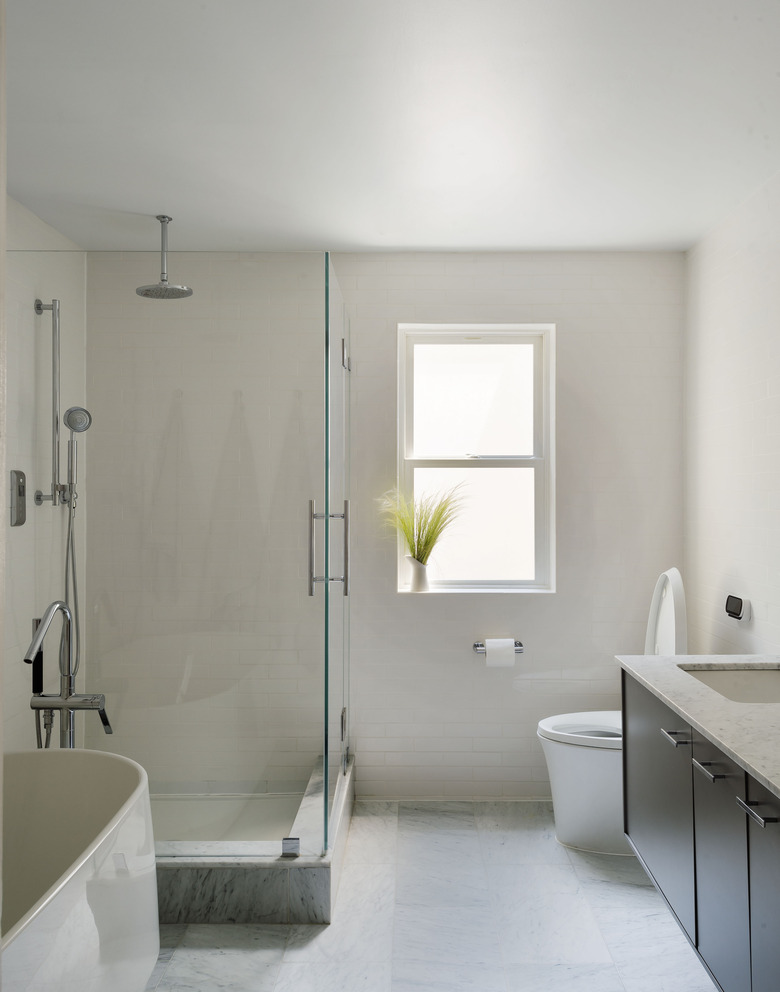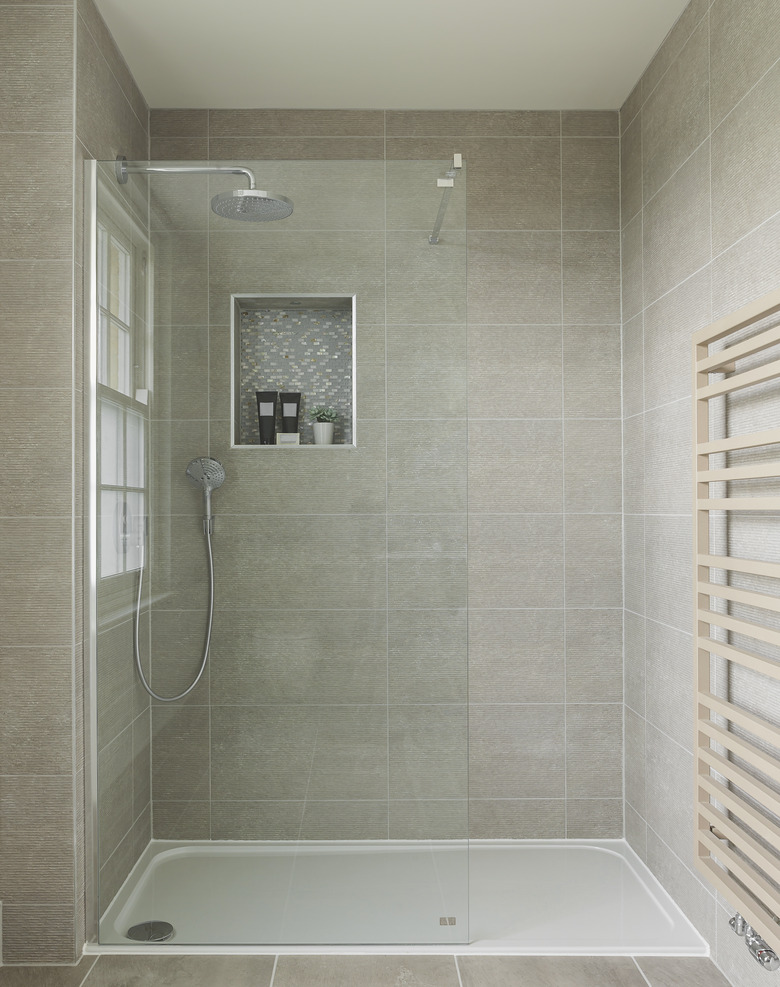How To Refinish A Plastic Shower Base
We may receive a commission on purchases made from links.
If you've ever refinished a wood tabletop or have done body work on your car, you won't have any trouble refinishing your acrylic or fiberglass shower base because the procedures are similar. You need a different type of paint than you would use for wood or metal, of course, and many manufacturers supply relatively inexpensive two-part epoxy paint specially formulated for plastic shower pans and bathtubs. A typical kit contains epoxy and hardener, application tools, cleaning supplies and sometimes a special primer to prepare the surface for the paint.
The refinishing job may involve patching holes or cracks in the shower pan, and if so, you'll need a separate repair kit for that, and you won't have any trouble finding one of these either. A typical repair kit contains two-part epoxy filler, application tools and sometimes fiberglass mesh cloth for patching large holes. If your kit doesn't include this cloth and you need it, you can purchase it separately.
DIY Shower Base Refinishing Supplies
DIY Shower Base Refinishing Supplies
Any product made for an acrylic or fiberglass tub will work on an acrylic or fiberglass shower pan, and the most popular product, which also happens to be one of the least expensive, is the Rust-Oleum tub and tile refinishing two-part kit. Recommended by Plumbing Lab, it covers 110 square feet, which is more than enough for a shower pan and would even allow you to apply two coats. It's one of the least noxious of the products out there, and your shower is ready to use 24 hours after you apply the last coat.
The Rust-Oleum kit doesn't include anything other than the paint and hardener, so if you're looking for one that includes applicators and cleaning supplies, you may prefer the Homax tub and tile refinishing kit, which costs just a few dollars more. You get less coverage with the Homax product, but since a shower pan is small, you'll definitely have enough for one and maybe two coats. If you're looking for spray paint, Homax sells an aerosol tub and tile refinishing kit for about twice the price of the regular one, but be forewarned: Professional refinishers, such as Paint Life TV, are less than impressed with the results of aerosol sprayers.
If you have to fill small holes or cracks as part of the refinishing process, the most highly reviewed repair kit is the Devcon epoxy bathtub repair kit, but for larger cracks in acrylic and especially fiberglass, you're better off with the Bondo 8 oz. fiberglass resin repair kit, which comes with applicators, fiberglass mesh cloth and even a mixing stick and mixing tray (but no sandpaper, which you have to purchase separately). If you're repairing a hole or crack that was caused by a lack of support, you'll also need a can of Great Stuff Pro spray foam or a similar product.
Things Needed
-
Fiberglass resin repair kit
-
Tub and tile refinishing kit
-
Rubber gloves
-
Cloth or scrubbie
-
Respirator
How To Refinish a Shower Base
How To Refinish a Shower Base
Since you're only refinishing the shower base, you'll want to mask off the floor around it and the rest of the shower stall, although you should wait until you've finished cleaning the shower pan before doing this. Once cleaning is complete, wrap a plastic bag around the showerhead to prevent any water from dripping onto the fresh paint.
1. Clean the Shower Base
Thrift Diving recommends lightly scraping the shower base with a sharp razor scraper to remove layers of caked-on soap scum. Scrape it over all the smooth parts of the shower pan, including the curb, but don't scrape any textured portions. Use the razor blade to remove any caulking on the curb, sides or floor of the shower base.
When you're done, mix 1/2 cup of trisodium phosphate (TSP) with a gallon of warm water. Wash the shower base thoroughly and rinse well. The TSP may come with your refinishing kit, or you may have to purchase it separately. It's caustic, so wear rubber gloves while using it.
2. Spray Foam for Support
Make a series of holes around a large crack or hole that is the result of insufficient support under the shower base using a drill and a 3/8-inch drill bit. Spray high-density foam into each hole until it begins to overflow. Wait for the foam to set and then cut it flush to the shower base with a knife and make a little indentation to allow room for epoxy resin.
3. Repair Cracks and Holes
Use a fiberglass resin repair kit to repair a small hole. Begin by scuffing the area around the crack with 220-grit wet/dry sandpaper and then mix the filler and hardener that come in the kit according to the directions. Spread the filler on small holes with the applicator that comes in the kit or with a plastic putty knife. Scrape off the excess and sand the repair flat when the resin sets. If you have to repair a hairline crack, drill a 3/8-inch stop hole at either end to prevent it from spreading.
Repair a large hole by scuffing the area around it with sandpaper, applying epoxy to the perimeter and laying a piece of fiberglass mesh cloth over the hole. Flatten the edges of the cloth into the epoxy and let it set. Then, apply one or two more coats over the cloth and scrape the epoxy level. Sand the repair flat when the final coat sets.
4. Tape Off the Floor and Shower Walls
Lay a layer of masking tape and masking paper on the floor in front of the shower base and on the shower walls directly above the base. Pry off the shower drain strainer with a flat-head screwdriver.
5. Scuff the Entire Shower Base
Use 220-grit sandpaper to scuff the entire shower base. The purpose of sanding is to dull the finish, so keep going until no part of the base is shiny.
6. Apply Primer
If your tub and tile refinishing kit comes with primer, apply it according to the directions. Most primers come as a clear liquid that you apply with an abrasive cloth or a kitchen scrubbie. The primer dries quickly, so you can paint immediately. Wear a respirator and keep a window open while working with it.
7. Mix the Paint According to the Directions
Mix the paint in the container in which it comes. Pour in the amount of hardener specified by the manufacturer and stir well. Add a nonslip texture to the mixture if desired. If you plan on painting two coats, transfer half of the paint to another container before adding hardener.
8. Spread the First Coat
Apply the paint with the applicator that comes with the kit. If no applicator is supplied, you can spread it with a foam brush or a foam roller. Avoid using a conventional brush or roller if you don't want to see brush strokes or roller marks when the paint dries. (Hint: you don't.)
9. Scuff and Apply a Second Coat
Let the epoxy dry for the time recommended by the manufacturer and then scuff the shower pan lightly with 220-grit sandpaper. Wipe away the sanding dust with a damp cloth and apply a second coat.
10. Apply Polish and Buff (Optional)
If you want a higher-gloss finish than the paint provides by itself, rub auto wax on the finished surface after the paint has fully cured. To avoid creating a slipping hazard, use the wax only on the sides of the pan and not on the bottom. Buff it to a high gloss with an electric buffer.


